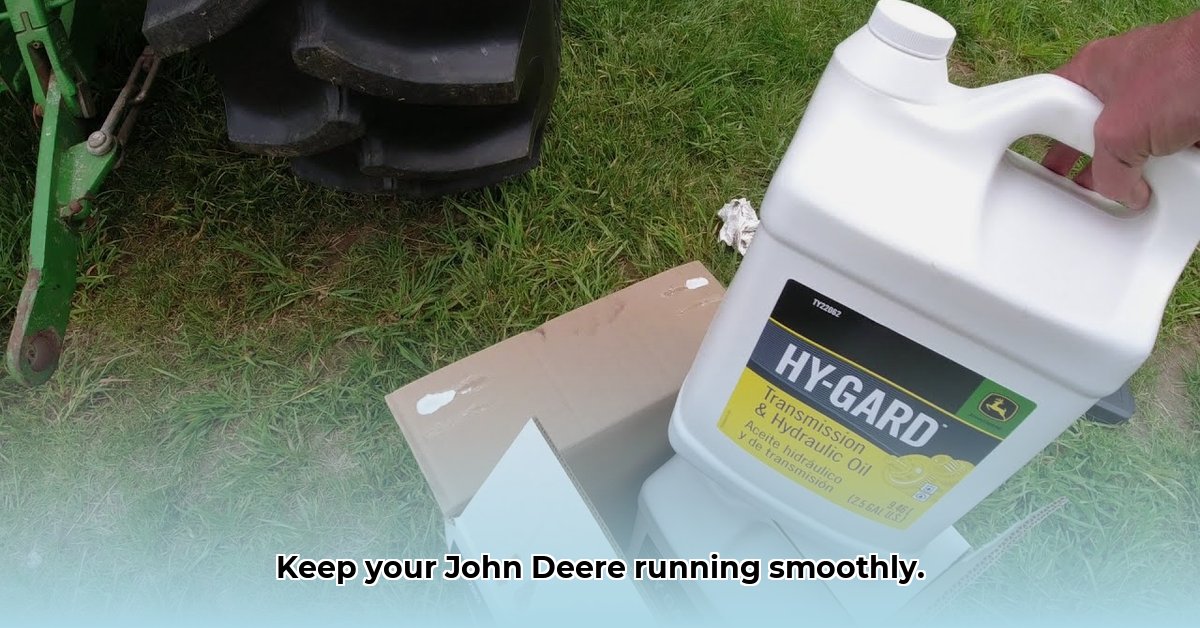
Understanding Your Tractor's Hydraulic System
Your John Deere tractor's hydraulic system is its powerhouse, responsible for everything from lifting implements to steering. Think of it as the circulatory system of your machine – hydraulic oil acts as its lifeblood, transferring power throughout. Maintaining this system is crucial for peak performance and avoiding costly repairs. Neglecting it can lead to significant problems down the road. Did you know that 75% of hydraulic system failures are directly linked to poor oil maintenance? For more information on John Deere tractors, check out this helpful resource: John Deere Tractors.
This guide will help you understand and maintain your tractor's hydraulic system efficiently and sustainably, using the correct oil for optimal performance and minimizing environmental impact. We'll cover everything from choosing the right oil to implementing sustainable disposal practices.
Choosing the Right Hydraulic Oil
Using the incorrect hydraulic oil can cause serious damage to your John Deere tractor. Your owner's manual is your primary reference; it specifies the exact type and grade required for your model. Deviating from these recommendations can lead to reduced performance, premature wear, and expensive repairs. This is not an area where shortcuts should be taken.
Besides following the manufacturer's instructions, consider your operating climate. A thicker oil might be needed in hot summer conditions to prevent overheating, while a thinner oil is preferable in cold winter temperatures to ensure easy flow. Your owner's manual should provide seasonal recommendations.
Maintaining Your Hydraulic System: A Regular Maintenance Plan
Preventative maintenance is key to extending the life and efficiency of your tractor's hydraulic system. It's far more cost-effective to address issues early than to deal with major breakdowns. Follow this routine:
Check the Oil Level: Regularly inspect the oil level using the dipstick to ensure it's within the recommended range. Low oil levels can severely damage the system.
Inspect Oil Condition: Examine the oil's appearance. Discoloration, cloudiness, or an unusual odor signal contamination or degradation, requiring an oil change.
Change Oil and Filter: Adhere to the oil change schedule outlined in your owner's manual. While it may seem like an additional expense, regular changes significantly extend the life of your hydraulic system. Always use the correct John Deere-approved filter.
Check for Leaks: Regularly inspect for leaks around hydraulic components. Addressing leaks promptly prevents costly repairs and environmental damage. A small leak can quickly escalate into a major problem.
Sustainable Practices: Responsible Farming
Modern agriculture emphasizes sustainability. Responsible hydraulic oil management is a vital element of this movement. Here's how to contribute:
Proper Disposal: Never dispose of used hydraulic oil improperly. This is harmful to the environment and illegal in most jurisdictions. Use designated collection centers for used oil—many agricultural supply stores or waste management facilities offer this service. Always consult your local regulations.
Preventative Maintenance: Regular inspections minimize leaks and environmental damage. A small leak can result in considerable oil waste.
Eco-Friendly Oils: Explore biodegradable hydraulic oils (BHOs). These options, made from renewable resources, break down more readily, minimizing environmental impact. These are becoming increasingly available and offer a sustainable alternative.
Troubleshooting Common Problems
Even with meticulous maintenance, problems can arise. Here's a basic troubleshooting guide:
Sluggish Response: Slow or unresponsive hydraulic functions often indicate low oil levels or a clogged filter, requiring immediate attention.
Leaks: Immediately pinpoint and address any leaks. Small leaks can be repaired easily, while larger ones may need professional attention. Ignoring leaks leads to oil loss and costly repairs.
Unusual Noises: Grinding, whining, or other unusual sounds suggest worn components needing repair or replacement. Addressing these early prevents escalating damage.
Long-Term Vision: Sustainable Farming
Maintaining your John Deere tractor's hydraulic system is an investment in the long-term health of your farm and the environment. Regular maintenance, suitable oil selection, and responsible disposal practices extend your equipment's life while minimizing your environmental footprint. This strategy benefits both your financial health and the planet. Dr. Emily Carter, Professor of Chemical and Biological Engineering at Princeton University, emphasizes, "Sustainable practices aren't just a trend; they're a necessity for the future of agriculture."
Choosing Eco-Friendly Hydraulic Oil for Sustainable Farming
This section focuses specifically on selecting and using environmentally friendly hydraulic oils (BHOs). These offer a significant advancement in sustainable agricultural practices. Switching to BHOs directly contributes to a more responsible farming model.
Understanding Your John Deere's Hydraulic System Needs
Before selecting a BHO, assess your tractor's specific needs. Consider operating conditions (temperatures, dust levels) to ensure the chosen BHO can handle those demands. Consult your owner's manual for detailed specifications.
Factors Influencing BHO Selection
- Performance: Ensure the BHO meets your tractor's performance requirements, including viscosity and temperature range.
- Biodegradability: Opt for high biodegradability ratings for quicker environmental breakdown.
- Toxicity: Prioritize low-toxicity oils to reduce harm to wildlife and soil.
- Cost: While BHOs might be more expensive upfront, their long-term environmental and financial benefits usually outweigh the initial cost.
Step-by-Step Guide to Selecting and Changing Hydraulic Oil
- Consult your John Deere manual: Identify recommended specifications.
- Research BHO options: Find suppliers offering suitable BHOs.
- Compare specifications: Assess biodegradability, toxicity, viscosity, and temperature ranges.
- Order the correct amount: Ensure you have enough oil to completely replace the existing fluid.
- Drain old oil: Follow manufacturer recommendations for draining and filtering used oil. Dispose responsibly.
- Add new BHO: Carefully add the new oil, adhering to the filling procedures and levels from your owner's manual.
- Check fluid levels: Confirm the hydraulic oil level is correct.
- Run the tractor: Briefly operate the tractor, checking for leaks or performance issues.
Pros and Cons of Biodegradable Hydraulic Oils
| Pros | Cons |
|---|---|
| Environmentally friendly | Potentially higher initial cost |
| Reduced environmental impact | May have slightly different performance characteristics |
| Biodegradable | Availability may be limited regionally |
Future Trends in Sustainable Hydraulic Fluids
Ongoing research promises even more sustainable options with enhanced performance, matching or exceeding traditional oils while maintaining environmental responsibility.